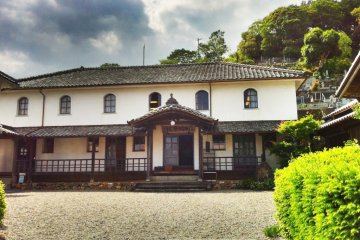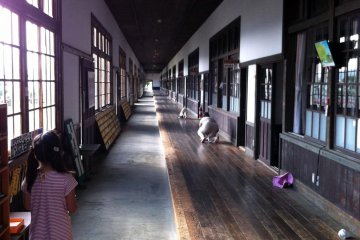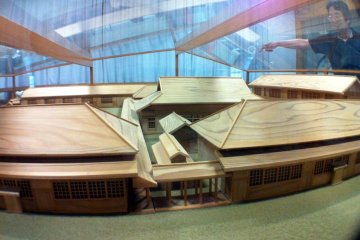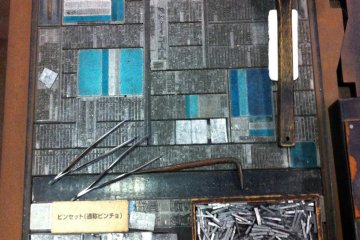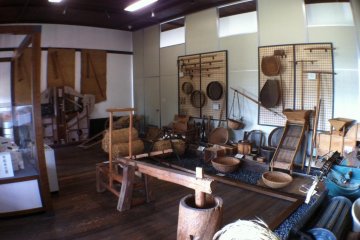The heart of the ‘city’ known as Seiyo is the little town of Uwa, and in the middle of Uwa is an area called Unomachi. This is a single street of old buildings dating from the Edo Period and later. In this area there are four separate museums, all of which are worth a visit. Here we’ll have a look at the Uwa Rice Museum (宇和米博物館 Uwa Kome Hakubutsukan in Japanese).
The Rice Museum is located a short distance from the main street of Unomachi on top of a steep concrete embankment. The buildings housing the museum are actually two separate wings of the old Uwa Elementary School, built in 1928. When the old wooden school was replaced with a concrete structure, two corridors and the gymnasium were moved up the hill and faithfully reconstructed. The ginko tree, which used to stand in the center of the school, was also relocated.
The first building seems to go on forever—it stretches for 109 meters, which creates some interesting effects of perspective. The other end of the corridor is so far away that you can hardly see it. It’s almost surreal. I visited the school/museum with a friend from Uwa who graduated from the old elementary school. As we wandered down the corridor entering this room and that, he went into a quiet daze of nostalgia. “I remember this room. It was really cold in winter. We had a coal burning stove, and we had to haul the coal to the classroom ourselves”. You can experience something of the life of a Showa era pupil yourself—the staff will give you a wet rag, and time you as you scuttle down the corridor, rag to the floor and rump in the air, swabbing the floorboards. You can get a little stamp to prove you did it.
The museum houses some very interesting exhibits about the cultivation and marketing of rice, with many real tools and machines from various periods in history. There’s also a schoolroom preserved as it was, and in a separate building, a scale model of the old primary school, showing it to be an impressively large building suitable for a time when Japan’s population was much larger. Ehime has traditionally been a prefecture which has placed a strong emphasis on education, and the old school was a veritable palace of pedagogy. The gymnasium isn’t normally open to the public, but my friend asked one of the staff if we could see it. She obligingly went to fetch the key, and let us in. The gym was a beautiful space with an elegantly curving ceiling and a little stage with pilasters. “I seem to remember there used to be a portrait of the Emperor or something here”, said my friend with a smile.
Admission to this museum is 200 yen for adults. Alternatively for 400 yen, you can get a ticket which includes this museum, the Kaimei School, the Museum of Folk Tools and the Philosopher’s Museum, which is a real bargain.



